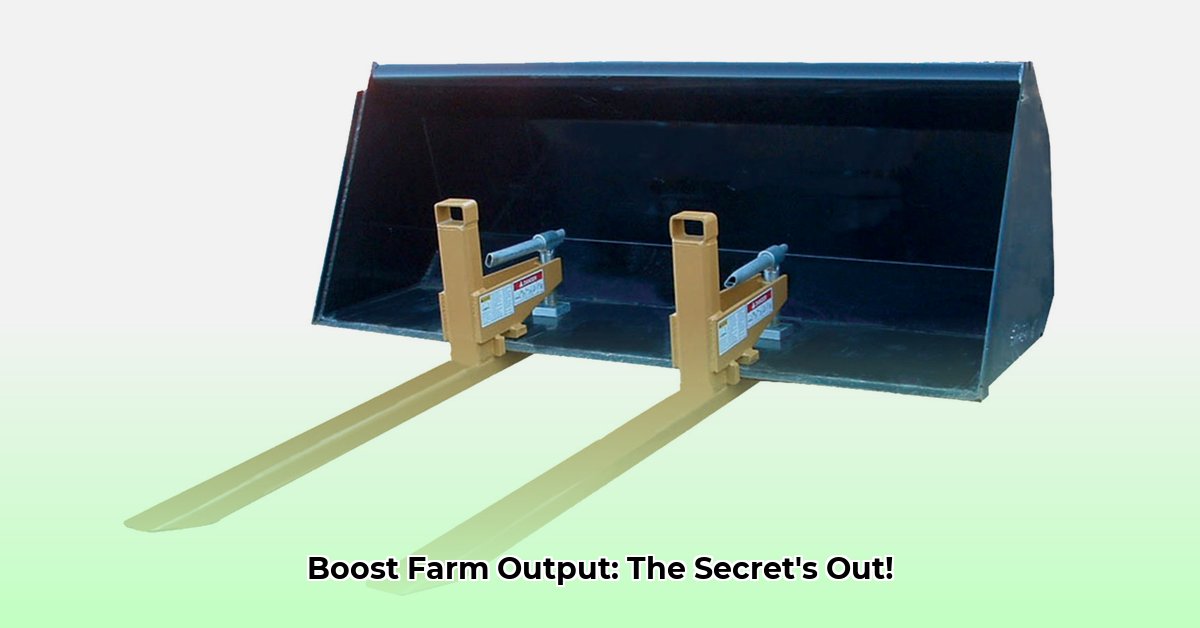
Clamp-On Tractor Forks: A Sustainable Farming Solution
Dealing with labor shortages, escalating fuel costs, and the ever-present risk of soil compaction? Clamp-on tractor forks offer a compelling solution, transforming your tractor into a versatile material-handling powerhouse. This article explores how these attachments boost efficiency, reduce environmental impact, and contribute to a more sustainable and profitable farming operation. By the end, you'll understand how to select, maintain, and utilize clamp-on forks to optimize your farm's sustainability. Isn't optimizing efficiency and minimizing environmental impact a goal every farmer shares? For more info on choosing the right forks, check out this helpful resource: Learn More.
How Clamp-On Tractor Forks Work
Clamp-on tractor forks securely attach to your tractor's front loader, transforming it into a robust lifting and moving system. Think of them as oversized, adjustable tongs. They're available in various sizes and weight capacities, ensuring compatibility with different tractors and load requirements. Many models feature adjustable stabilizer bars, enhancing stability when handling uneven or heavy loads. Before purchasing, always verify compatibility with your specific tractor model to prevent costly mistakes and ensure optimal performance. Wouldn't it be frustrating to find your newly purchased forks are incompatible with your tractor?
Benefits for Sustainable Agriculture
Clamp-on forks provide substantial benefits for sustainable agriculture practices. Firstly, they drastically reduce labor costs and time spent on material handling. Studies indicate a potential reduction in labor hours by up to 30%, directly translating to higher profitability. Secondly, the improved efficiency minimizes fuel consumption; smoother, more controlled movements translate to significant fuel savings – potentially as much as 15% – and a smaller carbon footprint. This efficiency improvement directly answers the critical question: how can I reduce my farm's environmental impact?
Furthermore, the precise handling minimizes soil compaction, preserving soil health and promoting long-term yield improvements. The reduced physical strain on workers also enhances safety and improves overall worker well-being. It’s a triple win: increased profitability, reduced environmental impact, and improved worker conditions. This underscores the significant role clamp-on forks play in modern sustainable agriculture.
Cost-Benefit Analysis: Investing in Efficiency
While clamp-on forks represent a significant upfront investment, their long-term benefits often outweigh the initial cost. A thorough cost-benefit analysis should include the purchase price, any needed tractor modifications, ongoing maintenance, and projected savings from reduced labor, fuel, and potential soil remediation costs. Remember to factor in increased potential yield due to improved soil health.
The return on investment (ROI) strongly depends on farm size and intensity. Larger farms with higher material handling volumes will generally experience faster returns compared to smaller operations. Consulting financial advisors specializing in agricultural investments is prudent for a comprehensive financial projection. Careful evaluation is critical to making an informed investment decision. Have you considered the long-term financial implications of adopting innovative farm technology?
Environmental Impact: Minimizing the Footprint
While promoting sustainability, it's crucial to evaluate the environmental impact of clamp-on fork production, use, and disposal. Choose durable, long-lasting forks made from recycled materials or produced using environmentally-conscious manufacturing processes. Supporting manufacturers committed to minimizing their environmental footprint is vital. Responsible disposal practices, including recycling options, further contribute to a lower overall impact.
Selecting the Right Clamp-On Forks: A Step-by-Step Guide
Choosing the right clamp-on forks requires careful consideration of several factors:
- Weight Capacity: Ensure the forks can handle your heaviest loads with a safety margin.
- Fork Length: Select a length appropriate for the materials you'll be moving.
- Tractor Compatibility: Verify compatibility with your specific tractor model.
- Stabilizer Bars: Adjustable stabilizers enhance stability, especially on uneven terrain.
- Material: Opt for durable yet lightweight materials resistant to wear and tear.
Maintenance and Safe Operation: Prioritizing Safety
Regular maintenance and safe operation are crucial for extending the lifespan of your forks and ensuring worker safety. Follow the manufacturer’s maintenance guidelines precisely, conducting regular inspections to detect and address potential issues early. Safe operation practices are paramount; never exceed the fork's weight capacity and always adhere to all safety guidelines. Operator training is highly recommended for safe and efficient operation. Investing in employee safety is investing in a prosperous future.
Future Trends: Integrating Technology
The future of clamp-on forks involves integrating advanced technologies like GPS-guided systems for automated material handling. Automated systems will further enhance efficiency, fuel savings, and soil preservation. This synergy between traditional methods and technological innovations is reshaping modern farming.
Conclusion: A Sustainable Investment
Clamp-on tractor forks represent a significant step toward building a more sustainable and profitable farming operation. By reducing labor costs, minimizing fuel consumption, and preserving soil health, they contribute to environmentally responsible farming while improving overall farm efficiency. Investing in this technology demonstrates a commitment to both short-term productivity and long-term sustainability. Embracing innovation is a key element in securing our agricultural future.